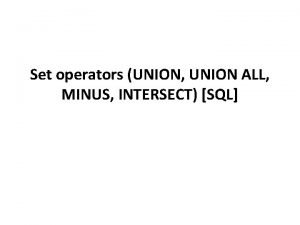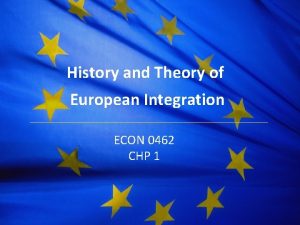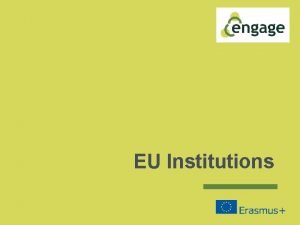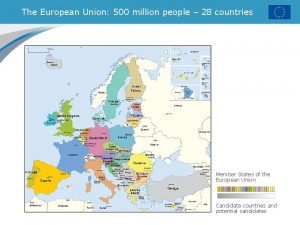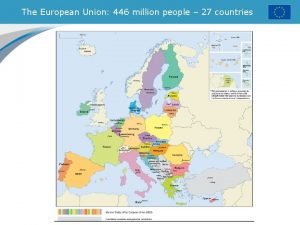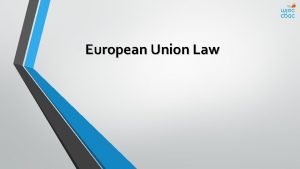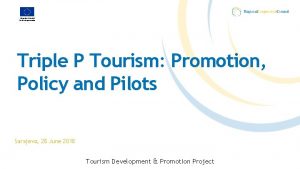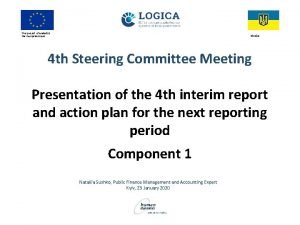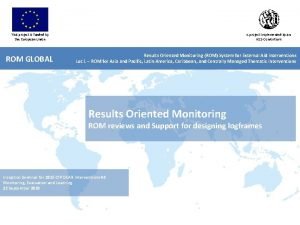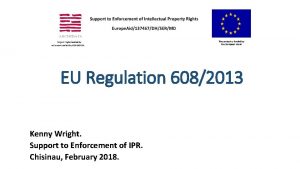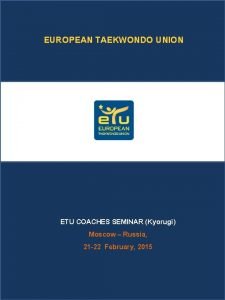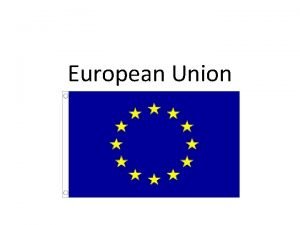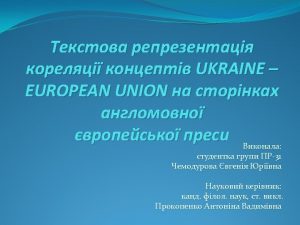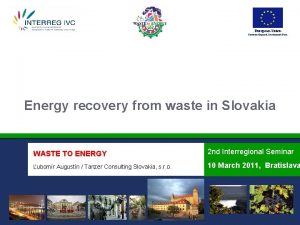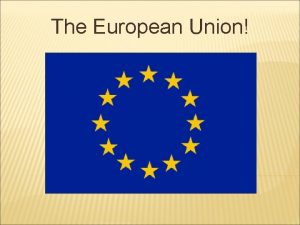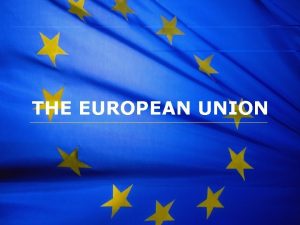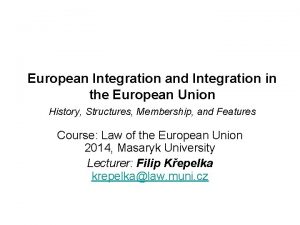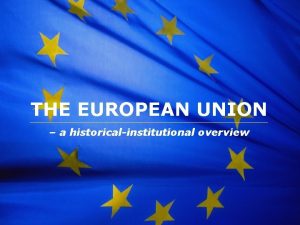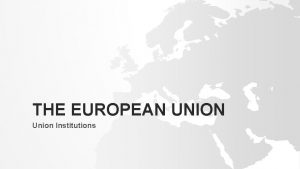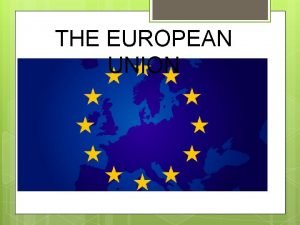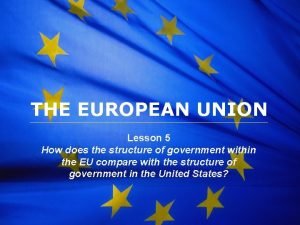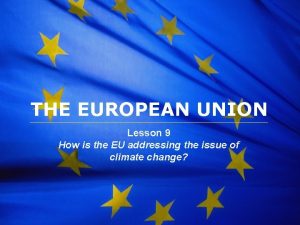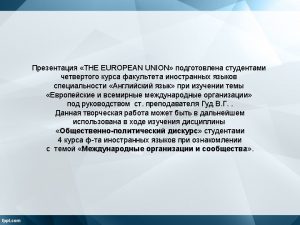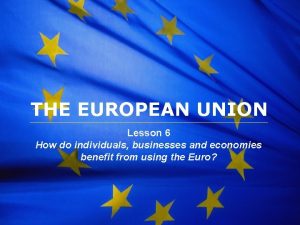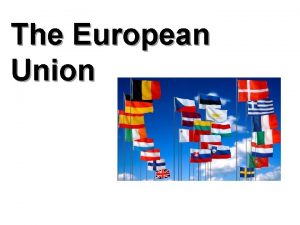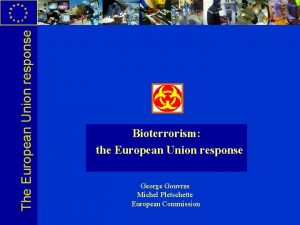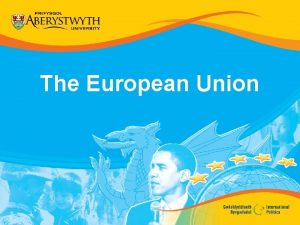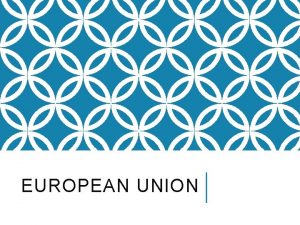European Integration and Integration in the European Union

























- Slides: 25

European Integration and Integration in the European Union History, Structures, Membership, and Features Course: Law of the European Union 2018, Masaryk University Lecturer: Filip Křepelka filip. krepelka@law. muni. cz

Dreams and nightmares of European unity • Long lasting dream of writers, scientists, artists or clergymen of united peaceful Europe. • Several projects of political union of European countries were proposed by monarchs and politicians. • Czech contribution: King Jiří/Georg Podiebrad (1458 -1471) • However, no project has been not realised until the second World War. Only partial aliances were built against other European countries. • Coercion was successful for short period of time and failed (Napoleonic wars, Nazi idea).

Integration since WW II • European Integration since 1945 has been based on the idea, that integration of nations (not only states) would preclude war among European countries. • The first impulse for after-war integration were atrocities of the second world war. • However, until today there are no United States of Europe (as they were proposed by Winston Churchill in 1946 for continental Europe). The United States model cannot be simply adopted in Europe.

International organizations for European integration • Basic legal instrument for integration is international law. • Several international organisations, established by international conventions and treaties which are agreed and ratified by founding states are visible expression of European Integration. • Plurality of international organisations allows differentiated membership. European countries can choose level of participation they estimate appropriate and suitable for them.

North Atlantic Treaty Organization • (1949) is defense covenant and international organization of many European countries joined together with the United States and Canada (28 members, not all EU member states are members of NATO). • Basic legal instrument is obligation of members for joint defense if any member has been attacked in north Atlantic area.

The Council of Europe (1949) • The Council of Europe is international Organisation with 47 member states including all EU member states) for administrative, social and cultural cooperation and enforcement of basic human rights. • Two hundred treaties and conventions have been concluded in the Council of Europe. • The European Court for Human Rights is attached to the Council of Europe. It enforces the Convention of Human Rights and Fundamental Freedoms.

The Organisation for Security and Cooperation in Europe (1975, 1991) • Since 1975, the Conference for Security and Cooperation in Europe was active and reorganized into Organization later. • The Organization is an international organisation expected by the Charter of United Nations for regional peace and security. The organisation joins 56 states of northern part of northern hemispere including all EU member states.

International organizations of former socialist countries • There was significant Integration of socialist countries behind iron courtain including former Czechoslovakia: • the Council of Mutual Economic Assistance (10 member states) for economic integration • and • military Warsaw Pact (7 member states)

Sectoral European Communities (coal and steel + atomic energy) • The European Coal and Steel Community was established (1952) for integration of coal and steel markets (important for both armament and reconstruction of damaged European economies several years afther the second world war). • One additional community was founded several years later (1957) by same states: the European Atomic Energy Community (Euratom) • The ECSC ceased to exist in 2002 because it was established for 50 years and there was little interest for continuation as specific organization.

European (Economic) Community (1957) • E(E)C was established for general economic integration with exception of sectors covered by already mentioned specialised European communities • Joint membership in all three/two communities (ECCS existed until 2002) is and was compulsory for all member states. • Enlargements of all European Communities and since 1993 simultanenously enlargements of the European Union. • Adjective „Economic“ dropped in 1993.

The European Union (1993) • The European Union was found with the Treaty of Maastricht as international structure. • It lacked legal personality. • It included two (three) European Communities (1 st pillar): and other forms of cooperation of member states: 2 nd pillar: i. e. common foreign and security policy, 3 rd pillar: i. e. cooperation in matters of (criminal) justice and interior.

EU = E(E)C + EU • Treaty establishing a Constitution for Europe expected merger of the European Community and the European Union. • „Reform“ Lisbon Treaty (agreed 2007) expected same change. It entered into force in December 2009. • In year 2010, the European Union has absorbed the European Community. • On the contrary, Euratom exists further.

Founding member states of the European Communities • Six original member states of the European Communities were: • France, Germany (west), Italy, the Netherlands, Belgium, Luxemburg.

Enlargements in 20 th century • Northern enlargement (1973): the United Kingdom, Ireland Denmark. Norway failed to ratify the treaty of accession. • Two southern enlargements (1981 and 1986): Greece, Spain and Portugal. • „Residual“ enlargement (1995): Austria, Sweden and Finland.

Enlargements in 21 st century • Great eastern“ enlargement (2004): Estonia, Latia, Lithuania, Poland, Czechia, Slovakia, Hungary, Slovenia, Malta and Cyprus. • „Additional eastern“ enlargement (2007): Romania, Bulgaria. • Small additional: Croatia (2013)

Prospective members • Turkey: permanent applicant? ! • Membership wished: several other Balcan and Eastern European states (Serbia, Montenegro, Bosnia-Hercegovina, Ukraine, Georgia, Moldova. • Negotiations proposed : Makedonia, Albania, • Dropped for disinterest: Iceland, Switzerland • How to define an European country which is entitled to ask for membership? • Russia, Israel, Morocco?

Major „Eurocrises“ • European Union faces several serious crises: • - debt crisis of several member states resulting in unexpected rescue loans and relaxed monetary policy which are controversial among the member states and result into debates of disintegration of the Euro • - refugee/migrant crisis showing incompatibily of area without border controls (Schengen) and missingle asylum policy • - illiberal tendencies in several states (Hungary, Poland) • - escalation of Catalan separatism… • - 2016 Referendum in Great Britain decided for BREXIT.

Actual disintegration „Brexit“ • Britons decided (23. 6. 2016) in referendum for withdrawal from the EU. • Internal disputes on legal preconditions until 2/2017. • Notification of withdrawal 3/2017. • 2 -years for negotiation on conditions with EUUK: soft brexit. • Otherwise, hard Brexit will materialize in 2019. • Withdrawal of withdrawal?

Developed European countries refusing the European Union • Membership possible and (would be) welcomed by member states, but rejected or not-applied for due to lack of support of population of these developped and democratic west European countries: Norway, Icenland, Switzerland. • These countries, however, have established, however, special legal arangements with the European Communities and their member states for partial economic integration.

The European Union as supranational organization • The European Union is an international organisation which shall be distinguished from numerous international non-governmental organizations. • There are several special features which cannot be found in other international organisations. • Nevertheless, the European Union lacks many features of federations. • Therefore, it is labelled as „supranational organization. “ • There is no similar structure in the world.

Overview of international organizations and federations • International organizations joining countries as members of international community: UNO, WTO, Co. E, OSCE, NATO etc. • Federations (federally organized countries composed of central and component states): USA, Germany, Switzerland, Russia, India, Australia, Brazil, Canada, Nigeria, Malaysia.

EU compared with international organizations • Principal legal differences: • Law of the European Union is applicable directly on individuals. • Laws and decisions can be adopted against member states. The Court of Justice has general jurisdiction. • Institutions of the European Union are emancipated from member states.

EU compared with federations • Until today, there are disputes on nature and position of this law in legal order of member states. Its supremacy (priority and direct effect) is sometime contested. • The European Union has no state power (no army, no police). • The European Union is weak if compared with all federations (limited budget) • The European Union has limited competence in foreign policy and defence.

No nation, no politics, stable statehood of member states • No social and political base for pan. European state: • No European nation (demos) and no Europe-wide politics. • Most member states have different (centuries, decades) tradition of statehood.

Multilingualism as explanation? • The principal ground for absence of European nation and European politics is absence of one (or two, or three) language(s) of general communication. • Every country needs one or limited number of languages of general communication. English has not yet achieved this position. • We can debate whether this language can achieve it in next decades.
 Intersect and minus in sql
Intersect and minus in sql 1993 europa
1993 europa Functions of european union
Functions of european union Co-funded by the erasmus+ programme of the european union
Co-funded by the erasmus+ programme of the european union Co-funded by the erasmus+ programme of the european union
Co-funded by the erasmus+ programme of the european union European union 28 countries
European union 28 countries European union 28 countries
European union 28 countries European union military
European union military Hinterland ap human geography
Hinterland ap human geography Https://europa.eu/european-union/index_en
Https://europa.eu/european-union/index_en This project is funded by the european union
This project is funded by the european union This project is funded by the european union
This project is funded by the european union Giorgi kacharava
Giorgi kacharava This project is funded by the european union
This project is funded by the european union This project is funded by the european union
This project is funded by the european union This project is co-funded by the european union
This project is co-funded by the european union Co-funded by the erasmus+ programme of the european union
Co-funded by the erasmus+ programme of the european union This project is funded by the european union
This project is funded by the european union Etu taekwondo
Etu taekwondo Eureka european union
Eureka european union Three dimensions of corporate strategy
Three dimensions of corporate strategy Forward backward integration
Forward backward integration Simultaneous integration meaning
Simultaneous integration meaning Hình ảnh bộ gõ cơ thể búng tay
Hình ảnh bộ gõ cơ thể búng tay Slidetodoc
Slidetodoc Bổ thể
Bổ thể
